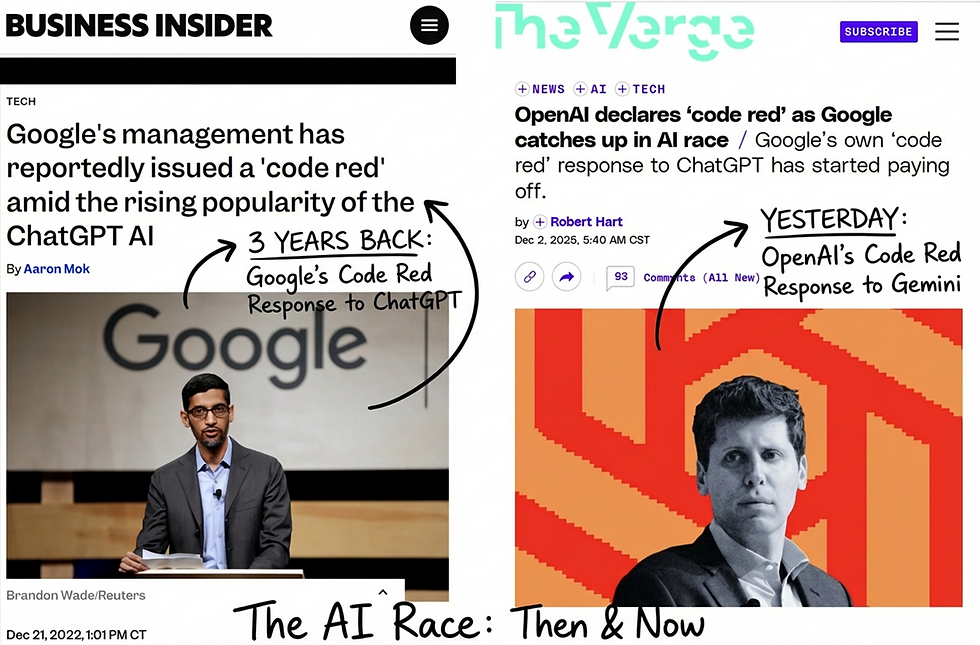AI Hallucinations: Feature or Bug?
- Ram Srinivasan

- Aug 14, 2024
- 3 min read
Updated: Jan 11

This week, as I've been diving deep into the latest advancements shaping the future of AI, one phenomenon has particularly captured my attention: AI model hallucinations. But what exactly are they, and why should we care? Let's break it down.
What is an AI model hallucination?
Imagine an AI confidently stating, "The Eiffel Tower was originally built in London in 1889 before being moved to Paris in 1900." Entirely false, yet plausible enough to mislead the uninformed. This is a hallucination - an AI generating false information presented as fact, stemming from its predictive nature and lack of true understanding.
Why do AI models hallucinate?
Several factors contribute to hallucinations:
1️⃣ Predictive design prioritizing likely word sequences over factual accuracy
2️⃣ Limitations in training data leading to bias or outdated information
3️⃣ Model complexity struggling with ambiguity or adversarial inputs
4️⃣ Over-extending learned patterns to unfamiliar scenarios
In a sense, hallucinations mirror human creativity and speculation but can lead to the spread of misinformation. So, what can we do about it?
Addressing hallucinations: A multi-faceted approach
Strategies to manage hallucinations involve techniques like:
Retrieval-Augmented Generation (RAG): Combining information retrieval with text generation to ground responses in verified facts
Knowledge-grounded models and in-context learning to provide relevant context
Improving training data quality and diversity
Implementing fact-checking mechanisms and uncertainty quantification
As developers, we must continually refine these methods to reduce hallucinations while preserving the benefits of AI-generated content. And as users, we can help by using clear prompts, verifying important information, and reporting inconsistencies.
The future of AI: Balancing creativity and reliability
Viewing hallucinations as a feature challenges us to harness AI's creative potential while ensuring reliability. By developing context-aware systems that distinguish between scenarios requiring strict accuracy (e.g., medical advice) and those where creative speculation is valuable (e.g., brainstorming), we can create more nuanced and versatile AI.
As we navigate this new frontier, ongoing research into understanding and controlling hallucinations remains crucial for building trustworthy AI systems that enhance our lives and work. The future is ours to shape, and it's up to us to steer AI development in a direction that maximizes its benefits while minimizing its risks.
What are your thoughts on AI hallucinations? Have you encountered any in your own interactions with AI?
—
A Message From Ram:
My mission is to illuminate the path toward humanity's exponential future. If you're a leader, innovator, or changemaker passionate about leveraging breakthrough technologies to create unprecedented positive impact, you're in the right place. If you know others who share this vision, please share these insights. Together, we can accelerate the trajectory of human progress.
Disclaimer:
Ram Srinivasan currently serves as an Innovation Strategist and Transformation Leader, authoring groundbreaking works including "The Conscious Machine" and the upcoming "The Exponential Human."
All views expressed on "Explained Weekly," the "ConvergeX Podcast," and across all digital channels and social media platforms are strictly personal opinions and do not represent the official positions of any organizations or entities I am affiliated with, past or present. The content shared is for informational and inspirational purposes only. These perspectives are my own and should not be construed as professional, legal, financial, technical, or strategic advice. Any decisions made based on this information are solely the responsibility of the reader.
While I strive to ensure accuracy and timeliness in all communications, the rapid pace of technological change means that some information may become outdated. I encourage readers to conduct their own due diligence and seek appropriate professional advice for their specific circumstances.


